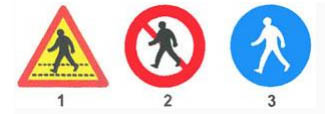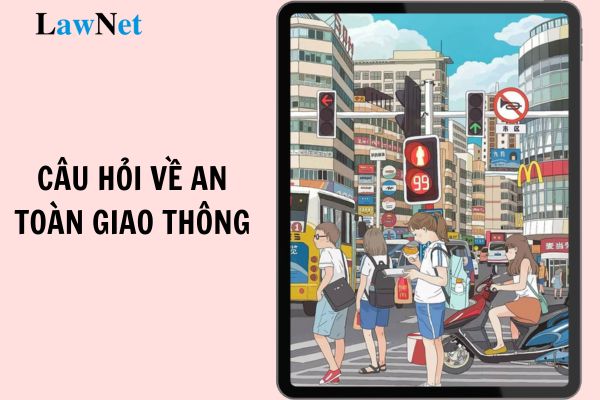What are the newest questions about traffic safety for primary school students in Vietnam? What are the 05 required outcomes regarding language competencies for 5th-grade students in the Vietnamese language curriculum?
What are the newest questions about traffic safety for primary school students in Vietnam?
Students may refer to the following newest questions about traffic safety for primary school students:
Newest questions about traffic safety for primary school students in Vietnam
Question 1: According to you, what should you pay attention to ensure safety while walking?
A. Walk in a line across the road with friends so that drivers can observe easily.
B. Walk on the sidewalk, roadside or close to the right edge of the road and always pay attention to observe
traffic vehicles
C. Walk on the road or close to the right edge of the road and always pay attention to observe
traffic vehicles
Question 2: Which of the following pedestrian crossing behaviors are unsafe?
A. Pay attention when crossing the road at places without overpasses, tunnels, and pedestrian crossings
B. Walk with an adult across the road
C. Climb over the median strip to cross the road faster.
Question 3: Can you cross the street when the pedestrian traffic light turns red?
A. Not allowed.
B. Only allowed when the road is clear of people and few vehicles are participating in traffic.
C. Allowed.
Question 4: When crossing the road at intersections without traffic lights, what should you do to ensure safety?
A. Stop on the sidewalk, roadside, or close to the curb => Look left, right, and left again until sure no vehicle is approaching => Run across the road quickly.
B. Stop on the sidewalk, roadside, or close to the curb => Look left, right, and left again until sure no vehicle is approaching => Cross the road, focus on observing safety and raise your hand high for other vehicles to recognize.
C. Both of the above options are correct.
Question 5: To ensure safety while playing, where should you play?
A. On the sidewalk or near the railway.
B. Children's playground.
C. Anywhere with shade.
Question 6: Is it safe to play on the pavement according to you?
A. Safe because there is no traffic crossing on the pavement.
B. Only places with wide pavements are safe.
C. Unsafe because you might bump into pedestrians or trees or run down the road, leading to an accident.
Question 7: Do you think you should wear a helmet when sitting behind a bicycle?
A. Yes, you should wear a helmet when sitting behind a bicycle to ensure safety.
B. No need, because bicycles move slowly.
C. Only wear it when it's sunny.
Question 8: How should you choose a helmet to protect your head?
A. A helmet of ensured quality and fits your head size.
B. An adult helmet of ensured quality.
C. Any helmet, as long as it fits your head size.
Question 9: Is it safe to sit in front of the motorcycle driver according to you?
A. Safe
B. Unsafe
C. Safe if the vehicle has a wide footrest.
Question 10: When can you stand behind the driver on a motorcycle or bicycle?
A. When the vehicle moves slowly
B. When the road is clear
C. Not allowed to stand behind the driver as it might affect vehicle control and lead to falling when braking suddenly.
Traffic safety quiz questions for primary school
1. What is the correct understanding of the concept "Traffic Controller"?
A. A person controlling a vehicle participating in traffic
B. A person assigned to guide traffic at construction sites, traffic congestion areas, ferry docks, road bridges shared with railways
C. A traffic police officer; a person assigned to guide traffic at construction sites, traffic congestion areas, ferry docks, road bridges shared with railways
D. All are correct
2. Who are included in "Road Traffic Participants"?
A. Drivers, users of road vehicles
B. Animal handlers, guides
C. Pedestrians on roadways
D. All three mentioned components
3. Which of the following actions are correct when participating in traffic?
A. Sitting properly in a car without opening the door, sticking out heads or limbs outside.
B. Sitting behind a motorcycle and extending arms or legs while moving.
C. Holding onto the rear of a moving car.
D. All are correct
4. How many people sitting on a motorcycle is not conformable?
A. Carrying 1 person behind.
B. Carrying 1 adult and 2 children under 11 years old behind.
C. Carrying 2 adults behind.
D. All are correct
5. When driving in an area where the road is under repair, what should a driver do?
A. Continue driving at normal speed.
B. Slow down, observe the signs or guide and follow accordingly.
C. Find a spot to maneuver the vehicle through as quickly as possible.
D. All are correct
6. Which road is unsafe?
A. Road with pedestrian crossing lines.
B. Paved or concrete road with a fixed median strip.
C. Road with many trees and buildings obstructing the view.
D. All are correct
7. How should you sit when being carried by an adult on a motorcycle for safety?
A. Wear a helmet and sit in front of the adult.
B. Wear a helmet, sit behind the adult, and hold onto them firmly.
C. Wear a helmet and sit behind the adult.
D. All are correct
8. How should traffic participants travel according to traffic rules?
A. Keep to the right according to their direction.
B. Travel on the designated lane.
C. Comply with road traffic signals.
D. All of the above.
9. Under what circumstances can the vehicle behind overtake on the right side of another vehicle in front while moving?
A. When the vehicle in front signals a left turn or is turning left.
B. When a tram is running in the middle of the road.
C. When a special operation vehicle is working on the road, and overtaking on the left is not possible.
D. All of those circumstances.
10. On the road, when a traffic controller's order conflicts with traffic lights or road signs, which order should be followed?
A. The traffic controller's order.
B. The traffic light signal.
C. The road sign indication.
D. All are correct.
11. How are offenses against the Road Traffic Law handled?
A. Must be handled stringently.
B. Must be handled promptly.
C. Must be handled according to the law.
D. All three options.
12. What types of vehicles, when performing emergency duties with sirens, flags, and lights according to regulations, are not restricted by speed?
A. Fire trucks, dyke protection vehicles, police vehicles, military vehicles.
B. Fire trucks, military vehicles, police vehicles, ambulances.
C. Fire trucks, military vehicles, police vehicles, ambulances, dyke protection vehicles, convoys escorted by the police.
D. All are correct.
13. Which sign prohibits pedestrians?

A. Sign 1
B. Sign 1 and 3
C. Sign 2
D. Sign 2 and 3
14. Which sign prohibits bicycles from entering?

A. Sign 1
B. Sign 2
C. Sign 3
D. Sign 1 and 3
15. Which sign indicates a lane for the disabled?

A. Sign 1
B. Sign 2
C. Sign 3
D. Sign 1 and 3
16. Essay Question:
Tell a story about traffic that impressed you, and through that story, express your thoughts on ensuring traffic safety today.
*Note: Information is for reference only./.

What are the newest questions about traffic safety for primary school students in Vietnam? What are the 05 required outcomes regarding language competencies for 5th-grade students in the Vietnamese language curriculum? (Image from Internet)
What are the 05 required outcomes regarding language competencies for 5th-grade students in the Vietnamese language curriculum?
According to the General education program in Literature attached to Circular 32/2018/TT-BGDDT, the required outcomes regarding language competencies for 5th-grade students in the Vietnamese language curriculum are:
- Focus more on understanding specific content, identifying themes, and understanding the lessons drawn from texts.
- Begin writing complete short essays, mainly narrative, descriptive essays, and simple introductions.
- Write narratives recounting the stories they have read, events they have witnessed, participated in, imagined stories; describe familiar objects and phenomena; introduce objects and activities close to their lives.
- Write paragraphs expressing their feelings, thoughts after reading a story, poem, witnessing an event that evokes emotions; express opinions on a simple academic or life issue; write several document types like autobiographies, text messages, invitations, schedules, applications,...; begin writing following a process; ensure the essay includes three parts (introduction, body, and conclusion).
- Clearly convey ideas and emotions; initially use appropriate gestures and expressions when speaking; clearly recount read or heard stories; share, exchange emotions, attitudes, thoughts on discussed topics; explain a simple object or process.
What are the required outcomes regarding literary competencies for 5th-grade students in the Vietnamese language curriculum?
According to the General education program in Literature attached to Circular 32/2018/TT-BGDDT, the required outcomes regarding literary competencies for 5th-grade students in the Vietnamese language curriculum are as follows:
- Know how to read expressively; retell, and summarize the main content of a story or poem.
- Evaluate characters, events, and the writer's attitude and emotion in texts.
- Recognize time, place, types of poetry, rhythm, beautiful, unique words, images, and the effects of personification, and comparison; comprehend the meaning or lesson from the text. Write stories, and descriptive essays showcasing emotion and the ability to relate and imagine.

